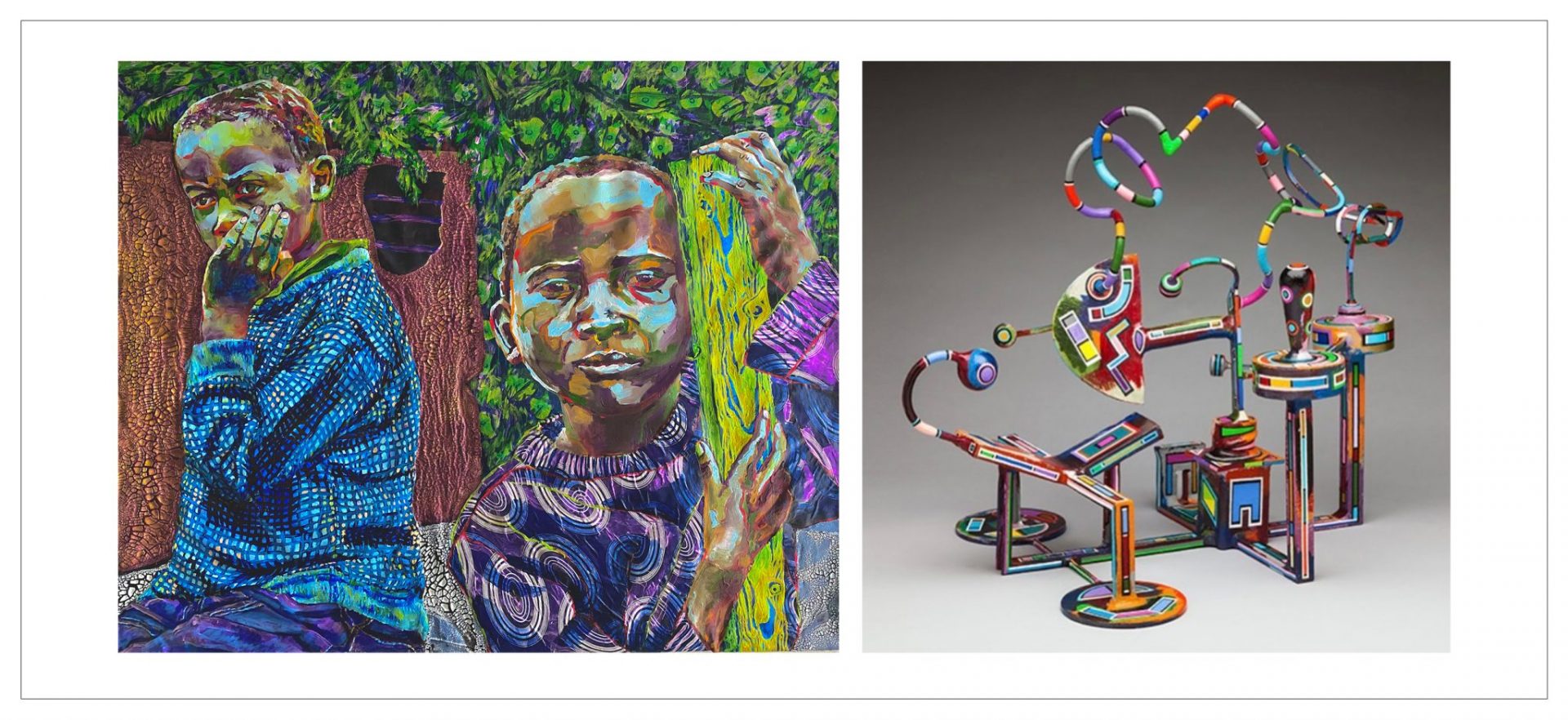Seeing is Believing
Heidi Brueckner and Joseph Slusky

Image left: Heidi Brueckner, Siblings with Mud House, 2020, oil, acrylic and paper on canvas, 34.5” x 42”
Image right: Joseph Slusky, Paraburdoo, 2018, steel, and acrylic and lacquer paint and polyeurathane paint, 23” x 30” x 20”
January 6 - February 12, 2022
Artists' Reception Saturday, January 15, 1 to 4 pm
GearBox Gallery is pleased to present Seeing is Believing, an exhibition of paintings by Heidi Brueckner and sculptures by Joseph Slusky. These two artists cross and connect in exuberant color and animated surfaces. Brueckner documents daily life in her portraits. She captures a moment, stopping time, while invoking a broader, continuing, narrative, activated with pattern and vibrant color. Slusky maps realms of the subconscious with gestural forms exotically painted, marking time and recording the unknown.
About the Artists
Heidi Brueckner

Brueckner’s work focuses largely on archetypes and portraiture as a way to study human nature. Typical of all her work is heavy use of texture, acidic colors, symbolism, and pattern referencing art and culture from around the world. Thematically the works cover topics such as social commentary about morality and cultural norms through figurative allegory, and portraits which are more individualistic narratives that explore personage through self-presentation, facial expressions, and gesture. The work often inspects the under-revered, and appreciates the subject’s presence and dignity, giving pause to honor the person.
Brueckner has been a professor of Art at West Valley College in Saratoga, California for over 20 years. Shegraduated from UC Santa Cruz with degrees in both Art and Art History, and earned an MFA in Painting from University of Kansas. During the past few years, she has published a book of her painting series entitled Monsterbet, and has shown her work widely nationally and internationally in over 100 solo and group shows.
During 2020-21 she won 11 first place awards and acknowledgements among others, including Italy’s International Prisma Art Prize and the Faber Birren Color Award. Brueckner lives and works in Oakland, California. Upcoming 2022 solo exhibitions will be at Buckham Gallery in Flint, MI; East Central College Art.
In Praise of Brueckner’s Work:
“I love the combination of the traditional format with freshness of the moment…[Brueckner is] faithful to the spirit of the person…[she is] obviously in love with every single mark.”
~René de Guzman, former Director of Exhibition Strategy and Senior Curator of Art, Oakland Museum of California, Oakland, CA
This is a fascinating and extraordinary work. Their eyes and direct gaze speak of longing and belonging…their faces and beautiful paint job struck me as such a direct and poignant piece.” (in reference to Siblings with Mud House)
~Donna Seager, Co-owner Seager Gray Gallery, Mill Valley, CA
“Aggression in color and line … whimsy in composition and expression. Strength and tenderness telegraph a redefined pietá of the contemporary street.” (in reference to Squatters Club, Cuba)
~Rick Pirozzolo, Executive Director & Curator, Arnot Art Museum, Elmira, NY
Joseph Slusky

The historic roots of Joseph Sluskey’s work are found in the cubist, constructivist and surrealist movements. The
sculptures and drawings explore realms of the subconscious; it is the unknown tis Slusky’s concern. The works
from the premise that within one, there are structures waiting to be excavated. The sculptures are like fossils- the imagination fossilized. The fascination and intrigue with the metal medium lies in its hardness and intransigence as contrasted with the more ephemeral human qualities of flesh and fluid. Slusky does not work from models or sketches, or any preconceived idea about the finished work. Each work is a fresh exploration or journey. The inherent aspects of sculpture explored in each work have to do with the objects multidimensional persona, the relationship between form and color, gesture, and tactility. Color is an essential aspect of the sculpture. Its evolution and integration with the sculptural form echoes the additive-subtractive process that occurs in the three-dimensional resolution of the work. Drawing is more immediate and direct in its nature. It can rapidly generate a multitude of ideas that in part reflect the sculptural forms or shapes that are being fabricated or manipulated at a particular time. In this way the drawing tends to keep the mind limber and agile in its confrontation with the harder, more obdurate metal medium.
Articles:
| Joseph Slusky: The Artist and the Dance 360, Summer 2006 by Andy Brumer |
The Fluidity of Felling and the Solidity of Form
Visions Art Quarterly, Spring 1994
by Andy Brumer
| Contrasts of Concept and Form Artweek, March 29, 1986 by Victoria Powers |
Caress of Steel, George Lloyd and Joe Slusky
The Portland Phoenix, November 3, 2000
Jenna Russell
Slusky in the Context of Modernist Tradition
From catalog essay in Joseph Slusky, Sculptural Survey, 1978-1998
The Oakland Museum of California sculpture court at City Center
by George Lloyd
| Better Living Through Alchemy ArtsBeat, Express, March 12, 1999 by Jack Foley |
|
